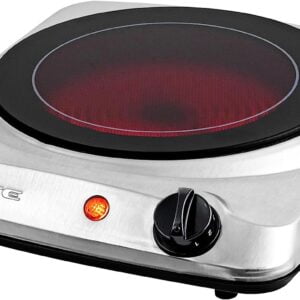Single Burner Portable Gas Stoves
Showing all 2 resultsSorted by popularity
-

Forimo Portable Propane Gas Cooktop, Single Burner Stove with Auto Ignition, Tempered Glass, Ideal for Camping, RVs, Apartments, and Outdoor Cooking
$55.99 -
Sale!

Gas One GS-3400P Portable Dual Fuel Stove – Propane and Butane Compatible – Camping Grill/Stove with Carrying Case, Adjustable Burners, and Wind Guards
Original price was: $32.99.$30.69Current price is: $30.69.
Single Burner Portable Gas Stoves: Compact and Versatile Outdoor Cooking
Single burner portable gas stoves are compact and lightweight cooking appliances that provide a convenient and efficient solution for outdoor cooking adventures. Whether you’re camping, hiking, picnicking, or simply need an emergency cooking option, these stoves offer the convenience of gas cooking in a portable package. In this guide, we’ll explore the features, benefits, usage, safety precautions, and maintenance tips for single-burner portable gas stoves.
Features of Single-Burner Portable Gas Stoves
Single-burner portable gas stoves are designed with simplicity and practicality in mind. Despite their small size, they come with a range of features that make them a popular choice for outdoor enthusiasts:
- Portability: The primary advantage of single-burner gas stoves is their portability. They are lightweight, compact, and easy to carry, making them perfect for backpacking, camping trips, and other outdoor activities.
- Single Burner: As the name suggests, these stoves have one cooking surface, which is ideal for cooking one pot or pan at a time. Though limited to one burner, they provide sufficient heat for most outdoor cooking needs.
- Fuel Canister Compatibility: Single burner portable gas stoves typically use small propane or butane gas canisters as fuel. These canisters are widely available and can be easily replaced during extended trips.
- Flame Control: Most stoves come with adjustable flame control, allowing you to regulate the heat output for precise cooking.
- Sturdy Design: These stoves are designed to be durable and stable, ensuring safe and hassle-free cooking even in rugged outdoor conditions.
- Wind Resistance: Some models feature built-in windshields or wind-resistant designs, protecting the flame from gusts of wind during outdoor cooking.
Benefits of Single-Burner Portable Gas Stoves
- Portability: The lightweight and compact design of these stoves make them easy to carry in a backpack or camping gear, making them an excellent companion for outdoor adventures.
- Quick and Convenient: Single burner gas stoves offer fast and reliable cooking. With a simple ignition, you can have your stove up and running in no time, ready to prepare your meals.
- Versatility: While limited to one burner, these stoves are versatile enough to handle a variety of outdoor cooking tasks, such as boiling water, cooking pasta, frying, and simmering soups and stews.
- No Electricity Required: Portable gas stoves do not rely on electricity, making them suitable for locations without power sources or during power outages.
- Safe and Efficient: With proper handling, single-burner portable gas stoves are safe and efficient cooking solutions. They have stable designs to prevent tipping and come with safety features to ensure user protection.
Using Single-Burner Portable Gas Stoves
Using a single-burner portable gas stove is straightforward:
- Setup: Choose a flat and stable surface to place the stove. Ensure it’s away from flammable materials and in a well-ventilated area.
- Fuel Setup: Screw the gas canister onto the stove’s fuel inlet according to the manufacturer’s instructions. Ensure the connection is secure.
- Ignition: Open the gas valve on the canister, and use the built-in igniter (if available) or a lighter/match to ignite the flame.
- Adjust Flame: Use the flame control knob to adjust the cooking temperature to your desired level.
- Cooking: Place your cookware on the stove’s cooking surface and start cooking. Monitor the heat and adjust the flame as needed.
Safety Precautions:
Safety is of utmost importance when using any cooking appliance. Here are some essential safety precautions for using single-burner portable gas stoves:
- Ventilation: Ensure there is proper ventilation in the cooking area to prevent the accumulation of gas fumes.
- Keep Away from Flammable Items: Position the stove away from flammable materials, tents, and shelters to prevent fire hazards.
- Stove Stability: Ensure the stove is placed on a stable surface to avoid tipping accidents.
- Supervision: Never leave the stove unattended while it’s in use.
- Cool Down: Allow the stove to cool down completely before handling or storing it.
Maintenance and Cleaning:
Proper maintenance will ensure the longevity and optimal performance of your single-burner portable gas stove:
- 1. Cleaning: Clean the stove after each use to remove food residue and dirt. Use mild soap and water to wipe down the stove’s surface.
- 2. Check for Damage: Inspect the stove before each use to ensure there are no cracks, leaks, or damaged parts.
- 3. Gas Canister Safety: Store gas canisters in a cool and well-ventilated area, away from direct sunlight and extreme heat.
- 4. Store Properly: Store the stove in a cool and dry place when not in use.
Conclusion:
Single burner portable gas stoves offer a convenient and efficient cooking solution for outdoor enthusiasts, campers, hikers, and anyone in need of a portable cooking appliance. Their compact size, ease of use, and versatility make them a valuable addition to any outdoor adventure or emergency preparedness kit.
By following safety precautions and performing regular maintenance, you can enjoy safe and enjoyable cooking experiences with your single-burner portable gas stove during all your outdoor escapades. Happy cooking!



